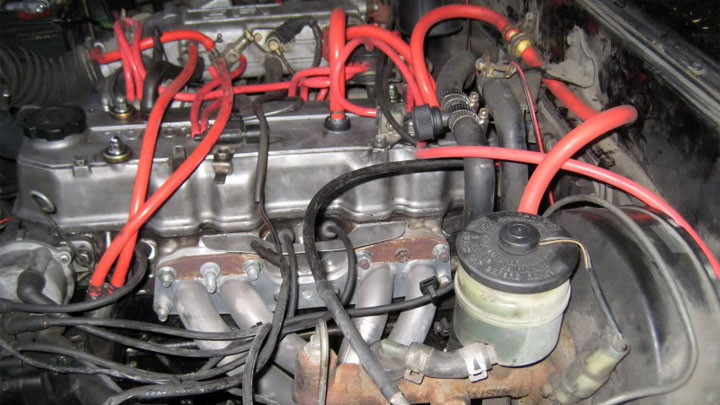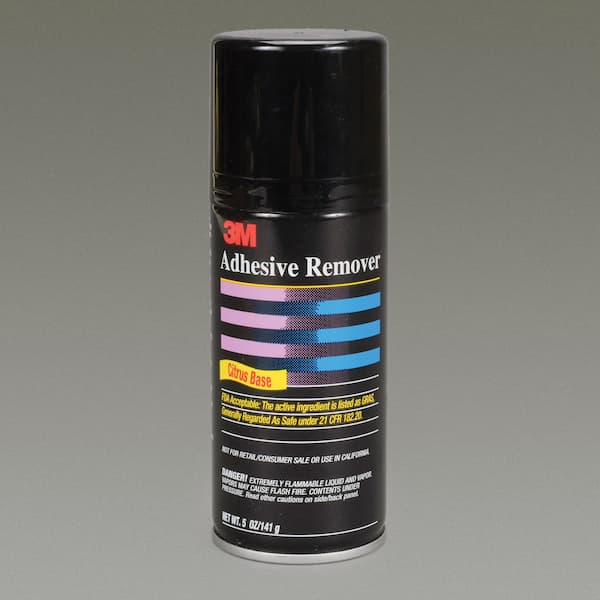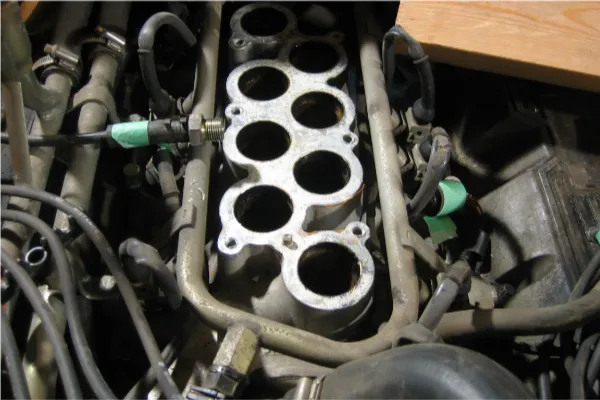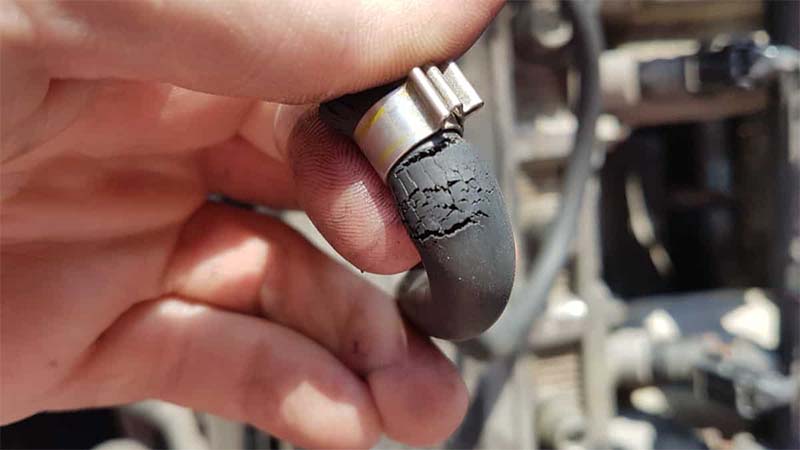A vacuum leak in a car indicates that air is getting into the engine through gaps that ought to be sealed. In the event that you are unable to locate the leak immediately, you are supposed to follow the steps on “how to find a vacuum leak“.
Here is a quick guide to help you find a vacuum leak:
- Visually Inspect Vacuum Hoses
- Start the Engine
- Get a Flammable Spray Ready
- Spray Around Intake Manifold Gasket
- Spray Around Vacuum Hoses
- Spray Around Brake Booster Hose
- Spray Around Solenoids & Actuators
- Spray Around Throttle Body
This manual not only offers helpful repair advice and assists you in locating vacuum leaks or obstructed vacuum hoses, but it also explains what engine performance issues could be an indication of a vacuum leak.
How to Find a Vacuum Leak?
When the engine is idle, carefully mist a flammable liquid around the areas where you suspect the leak may be coming from to locate vacuum leaks at home. There is a vacuum leak there if the engine RPMs rise.
If you use this method carelessly, you run the risk of setting your car on fire. To find vacuum leaks, we always advise using the proper equipment! Always do it outside, and do it at your own risk. Ensure a fire extinguisher is accessible. (Note: Avoid spraying close to hot or ignition parts.) Only experts should carry out these actions!
Visually Inspect Vacuum Hoses

Checking all of the vacuum hoses for cracks or complete breaks should be your first action before continuing with this guide. The rubber used in vacuum hoses, which is susceptible to cracking when exposed to the heat of an engine, eventually becomes hard. Vacuum hoses that are damaged should be changed.
Start the Engine
It’s time to start the engine if you didn’t discover any broken or leaking vacuum hoses or other components in the engine bay. Put the gearbox in Neutral or Park and start the engine after applying the parking brake. Throughout this guide, take care not to touch any hot or moving parts!
Get a Flammable Spray Ready

You’ll need a flammable fluid in spray or gas form to continue with this guide. Starter spray, brake cleaner, carburetor cleaner, or propane gas from a torch powered by propane are a few examples. For these procedures, we do highly advise using a propane torch or carburetor cleaner.
Spray Around Intake Manifold Gasket
Using the spray, carefully spray the area around each cylinder’s intake manifold connection to the cylinder head. Your car probably has a damaged intake manifold gasket if the engine speed changes or the sound changes. If the intake manifold is split into multiple sections, you can also try spraying around other suspected areas there.
Spray Around Vacuum Hoses
Find the locations of all the vacuum hose connections on the intake manifold, and spray all around those areas. Even if they appear to be in good condition, they may have tiny leaky cracks. You can also spray the hoses’ opposite ends by following them. You’ve definitely discovered a vacuum leak if the engine RPM changes to higher or lower values.
Spray Around Brake Booster Hose
To ensure that you do not need to apply intense pressure to the brake pedal, the brake booster uses a one-way valve to create a vacuum. Try to find any leaks by spraying around the brake booster’s connection and other nearby areas. But because you are so far away from the engine, it’s unlikely that you will be able to hear the engine’s RPM here.
Spray Around Solenoids & Actuators
Search the intake manifold and follow the vacuum hoses to locate solenoids and actuators linked to the vacuum system. These solenoids and actuators are frequently constructed of plastic, which over time may crack. Spray around these, especially if the axles are attached to the intake manifold, as seen in the image above. If you find a leaky solenoid or actuator, replace it.
Spray Around Throttle Body
The gasket between the throttle body and the intake manifold is the final thing we need to check. A rubber or paper gasket is frequently used to seal the space between your throttle body and intake manifold, which is fastened together with three to four screws. Occasionally, this gasket degrades and begins to leak. Spray other areas close to the throttle body to look for leaks.
Vacuum Leak Symptoms
Here is a list of performance problems to keep in mind, as they might possibly be related to a vacuum leak:
- Backfiring
- Hesitation
- Hard starting
- Low engine power
- malfunctioning (usually at random. You may get trouble code P0300)
- Poor fuel economy
- Poor acceleration
- Rough idle
- depending on the vehicle model, either an extremely high or low idle.
- Stalling
- Stumbling
- Check Engine Light on
- Lean mixture is continuously reported by the oxygen sensor.
- Poor brake performance (on vacuum-type power brakes)
Remember that these signs are not limited to vacuum leaks. One or more of these symptoms, for instance, may also be brought on by faulty ignition timing, faulty compression, or faulty EGR valves.
Read about How Often Should You Vacuum?
Safety for Finding Vacuum Leaks
You must always take precautions when performing maintenance work. However, it’s simple to burn yourself or lose a few fingers while looking for vacuum leaks. So, if you don’t want to end up as dinner, you might want to keep these safety advice in mind.
- Put the usual suspects in there. A car’s engine is running, and you are underneath the hood. That means you want to throw on some safety glassesand gloves to protect the goods.
- Avoid touching moving parts with your fingers. Most of the tests we mention will be conducted while the engine is running. If you’re not careful, the fan and other moving parts will quickly mutilate your fingers whether you’re wearing gloves or not.
- You are exactly like a juicy hamburger. Once more, the majority of these tests are conducted with the engine running. Burgers and hot dogs may not scream on the grill, but if you touch any engine parts that have been slightly overheated, you will. Always be aware of what those parts are and keep your distance.
- Mind your Flammables. Some of the tests involve misting flammable liquids or gases onto engine parts while they are running. Be aware of the dangers and make sure to steer these substances as safely as you can.

Pro Tips to Finding Vacuum Leaks
- Potential vacuum leaks may be audible.Though vacuum leaks produce a distinct whistling sound, the engine compartment can be quite noisy. If you pay close attention, you might be able to identify the noise and locate its source.
- You can attempt to pinch the vacuum lines manually while the engine is running as an alternative to the vacuum gauge test. When the problematic component is removed from the manifold, you’ll notice that the idle gets better.
- Make sure the manifold is securely fastened. Don’t be too proud to go back and double-check your work if you recently installed an intake manifold and are having start and run problems.
- Be extremely cautious when carrying out the carb cleaner or propane enrichment tests. These are the two most preferred techniques for finding faulty gaskets because of how conclusive they are, but using them involves introducing flammable gases under a running car’s hood. Therefore, be cautious around hot surfaces and take care to stay away from them as you could start a big fire.
- The carb cleaner method doesn’t necessitate using carb cleaner. It also works with any other flammable liquid or starting fluid.
- There is a good reason why the propane enrichment test is preferred to the carb cleaner test. That is simply a result of the greater degree of control you have over the flow of propane gas. For even better control in confined spaces, you can go a step further and connect a flexible hose to the end of the nozzle.
Read about Best Vacuum for Thick Carpet
When Should I Troubleshoot for a Potential Vacuum Leak?
Vacuum hoses are a common source of engine performance problems. After many miles of use, vacuum hoses deteriorate, harden, split, or soften, and vacuum tubing weakens, becomes brittle, and breaks, leading to a variety of engine performance issues.
Therefore, incorporate a vacuum leak diagnostic into your repair strategy whenever you notice an engine performance issue but can’t seem to identify the cause.
You might come across various sensors and actuators that require a reliable vacuum source to function, depending on the make and model of your specific vehicle. A Manifold Absolute Pressure (MAP) sensor, for instance, is used by some engines to measure the pressure of the outside air. This sensor requires vacuum.
A MAP sensor vacuum leak can upset ignition timing and engine stability and efficiency. A vacuum leak can also prevent an EGR valve from opening, cause engine overheating, and increase harmful emissions. The Positive Crankcase Ventilation (PCV) system may be impacted by this type of leak as well.
FAQs About Vacuum Leaks
Is It Bad to Drive With a Vacuum Leak?
Yes, to answer briefly. The performance of your engine can be compromised by vacuum leaks, which can affect several crucial systems. You really shouldn’t drive if the car has a vacuum leak even if it is moving on its own power.
What Can I Spray to Check for Vacuum Leaks?
Any flammable liquid can be used. Since they increase engine speed when they enter through vacuum leaks, carb cleaners, brake cleaners, starting fluids, and propane are all frequently used for the process. Water can be used as an alternative because it makes a distinctive sound when it leaks into the engine.
Can I Use WD40 to Find a Vacuum Leak?
Yes, it is possible to find vacuum leaks using regular WD40. It will still function, even though its effect on the engine may not be as significant as that of carb cleaner or starting fluid. Remember that WD40 has a carb cleaner that is perfect for this test.
Is a Vacuum Leak Expensive to Fix?
Depending on the source, a vacuum leak’s repair cost will vary. Hoses and tubes that are damaged are rarely replaced for more than a few dollars. However, the expense of replacing an intake manifold, sensors, and gaskets can quickly add up to the total investment.
So, How to Find a Vacuum Leak?
As extra, unwanted air is introduced into the engine, a vacuum leak can result in a variety of drivability issues by leaning out the air/fuel mixture. Modern internal combustion (multiport fuel injection) engines use intake vacuum to drive sensors, actuators, and power brakes (on some vehicles). It is also used by some older engines to control emissions and to draw fuel into the combustion chamber.
Here is a quick guide to help you find a vacuum leak:
- Visually Inspect Vacuum Hoses
- Start the Engine
- Get a Flammable Spray Ready
- Spray Around Intake Manifold Gasket
- Spray Around Vacuum Hoses
- Spray Around Brake Booster Hose
- Spray Around Solenoids & Actuators
- Spray Around Throttle Body



